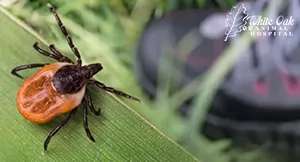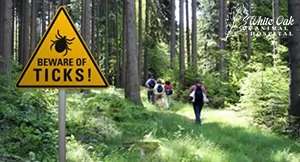
Understanding Canine Lyme disease is vital for the well-being of your furry friend. Lyme disease, caused by the bacterium Borrelia burgdorferi, poses a silent threat transmitted through the bite of infected black-legged ticks. Dogs and horses are susceptible to this infection.
Early detection of the disease’s symptoms is an intricate process. Merely 5-10% of infected animals exhibit clinical signs, often manifesting several months after the initial infection. To address this challenge, timely consultation with your veterinarian is imperative for accurate diagnosis and effective management.
In the pursuit of maintaining your pet’s health, it’s crucial to adopt preventive measures. Implementing rigorous tick control practices and considering vaccination can act as potent shields against Canine Lyme disease. By collaborating closely with your veterinarian and embracing these precautions, you’re taking significant steps to safeguard your cherished companion’s overall well-being and quality of life.
What is Canine Lyme Disease?
 Canine Lyme disease is a sneaky ailment caused by the pesky bacterium Borrelia burgdorferi, usually transmitted through the bite of those notorious black-legged ticks, also known as deer ticks. These tiny troublemakers can wreak havoc on our furry companions, leading to symptoms like lameness, swollen lymph nodes, joint swelling, fatigue, and loss of appetite in dogs, and even shifting-leg lameness, hypersensitivity, and poor performance in horses. Understanding this stealthy villain is key to protecting our four-legged pals.
Canine Lyme disease is a sneaky ailment caused by the pesky bacterium Borrelia burgdorferi, usually transmitted through the bite of those notorious black-legged ticks, also known as deer ticks. These tiny troublemakers can wreak havoc on our furry companions, leading to symptoms like lameness, swollen lymph nodes, joint swelling, fatigue, and loss of appetite in dogs, and even shifting-leg lameness, hypersensitivity, and poor performance in horses. Understanding this stealthy villain is key to protecting our four-legged pals.
Understanding the Intricacies of Canine Lyme Disease
 Canine Lyme Disease is like an uninvited guest that sneaks in with the help of those pesky black-legged ticks. You see, it’s all about that cunning bacterium called Borrelia burgdorferi. These tiny critters are like little disease-carrying ninjas. They latch onto your dog during outdoor escapades and, boom, infection potential right there.
Canine Lyme Disease is like an uninvited guest that sneaks in with the help of those pesky black-legged ticks. You see, it’s all about that cunning bacterium called Borrelia burgdorferi. These tiny critters are like little disease-carrying ninjas. They latch onto your dog during outdoor escapades and, boom, infection potential right there.
These ticks, they’re everywhere – in woods, tall grass, even your backyard. So, dogs exploring these tick-infested territories, are playing with fire, or in this case, Lyme disease. Now, imagine your dog is one of those that frolics in the woods, rolls in the grass, and ticks on playgrounds. Well, that furry explorer is more susceptible to this unwanted hitchhiker. Also, if you’re living in a Lyme disease hotspot, the risk goes up. And it’s not just location, certain breeds might be more prone to this unwanted visitor. So, keep an eye out for those ticks and know your pup’s risks.
Unveiling the Telltale Signs of Infection
 Early on, you might notice your furry friend’s energy taking a nosedive – like they’ve lost their pep. Then, there’s the whole limping thing, which can make you wonder if they’re playing some canine version of hopscotch. On top of that, swollen lymph nodes might pop up, like unexpected guests crashing a party.
Early on, you might notice your furry friend’s energy taking a nosedive – like they’ve lost their pep. Then, there’s the whole limping thing, which can make you wonder if they’re playing some canine version of hopscotch. On top of that, swollen lymph nodes might pop up, like unexpected guests crashing a party.
Now, if this disease isn’t caught in its early dance, it can get really serious. Dogs might start having trouble breathing as if they’ve been chasing squirrels non-stop. Their poor joints might start to swell and even a once hearty appetite can go MIA. Ever seen your pup with a droopy face? Well, that’s a late-stage symptom right there – a sign that this disease is pushing them around.
And here’s where early detection becomes the hero in our story. Just like with most things, catching the villain early can mean a better shot at a happy ending. Because if you can nab Canine Lyme disease before it starts throwing its weight around, treatment is often more effective. So, keep an eye out for these symptoms, even the subtle ones, and make sure your canine companion gets the attention they need.
Exploring Diagnosis and Treatment Strategies
 When it comes to figuring out if your pup is facing this challenge, blood tests are the go-to detectives. These tests can detect the presence of those tricky antibodies the body creates in response to the disease. If those antibodies are showing up, well, Canine Lyme disease might just be the culprit.
When it comes to figuring out if your pup is facing this challenge, blood tests are the go-to detectives. These tests can detect the presence of those tricky antibodies the body creates in response to the disease. If those antibodies are showing up, well, Canine Lyme disease might just be the culprit.
When caught early, antibiotics often step in as the heroes, fighting off those pesky bacteria causing all the trouble. Your vet might prescribe doxycycline or amoxicillin. Some folks lean towards a holistic approach, exploring the world of natural remedies. You might find yourself diving into herbal supplements, hoping nature’s arsenal can lend a hand.
Treating Canine Lyme disease isn’t a one-size-fits-all deal. It’s like creating tailor-made armor for your pup’s unique situation. So, consult your vet to guide you through the best strategies. Whether it’s the conventional antibiotic route or a more holistic journey, the end goal is to restore your furry friend’s vitality and keep them wagging their tail.
Effective Strategies to Minimize Canine Lyme Disease Exposure
Canine Lyme disease is no walk in the park. It can bring about a whole heap of trouble for your furry sidekick. We’re talking joint pain, lethargy, fever – the works. Preventing Canine Lyme disease is all about being one step ahead. Preventing this disease is like giving your pup a force field against these sneaky ticks. It’s not just about protecting them from physical discomfort, but also shielding their vitality and zest for life.
- Make tick checks a ritual. After every romp in the great outdoors, give your furry companion a good once-over. Those ticks can be sneaky, but with regular checks, you can catch them before they make themselves too cozy. Complete with thorough inspections to ensure they’re tick-free and beaming with happiness. Your pup will even come to appreciate these little grooming sessions as a sign of your unwavering care and devotion.
- Arm your fur baby with tick-prevention products. These are the ultimate armor against those pesky critters. With options like flea and tick collars, topical treatments, and even oral medications, you’re essentially creating a fortress of protection for your furry sidekick. So, remember, when you gear up your fur baby with these preventive products, you’re giving them the gift of carefree adventures and endless tail wags.
 Lyme disease vaccine. Similar to humans, dogs can be shielded from the risks of Canine Lyme disease through vaccination. Consulting your veterinarian is crucial in determining the right timing and approach for administering the vaccine. The vaccine trains their immune response to recognize and combat the Borrelia burgdorferi bacteria, reducing the likelihood of infection if exposed to infected ticks. By discussing this option with your veterinarian, you ensure your dog receives the appropriate protection, especially if they reside in areas prone to tick infestations.
Lyme disease vaccine. Similar to humans, dogs can be shielded from the risks of Canine Lyme disease through vaccination. Consulting your veterinarian is crucial in determining the right timing and approach for administering the vaccine. The vaccine trains their immune response to recognize and combat the Borrelia burgdorferi bacteria, reducing the likelihood of infection if exposed to infected ticks. By discussing this option with your veterinarian, you ensure your dog receives the appropriate protection, especially if they reside in areas prone to tick infestations.- Keep your outdoor space tidy. Ticks are known to thrive in tall grass and shrubs, so regular yard maintenance plays a pivotal role in reducing their habitat. By keeping your outdoor space trimmed and orderly, you minimize the chances of ticks finding a suitable breeding ground. A well-maintained yard acts as a barrier against tick infestation, allowing your furry companion to explore and play without the risk of encountering these disease-carrying parasites.
- Remember that you’re part of this defense team too. While you’re accompanying your dog outdoors, opt for well-cleared paths and steer clear of densely vegetated or overgrown regions where ticks tend to inhabit. This practice aligns with the concept of a joint effort – you and your dog collaborating to ensure safety. By choosing routes that minimize tick exposure, you’re contributing to the overall preventive strategy.
Dear pet owners, a proactive stance against Canine Lyme disease is a vital safeguard for your cherished companions. This hidden menace can bring about substantial health concerns for your furry friends. Therefore, taking preventive actions is of utmost importance in shielding them from this silent threat.
 Never underestimate the impact of maintaining a vigilant eye for symptoms and practicing preventive measures. The well-being of your pets greatly depends on your commitment to their protection. Regular tick checks, investing in reliable tick control products, and considering vaccinations can play a pivotal role in curbing the risks associated with Canine Lyme disease.
Never underestimate the impact of maintaining a vigilant eye for symptoms and practicing preventive measures. The well-being of your pets greatly depends on your commitment to their protection. Regular tick checks, investing in reliable tick control products, and considering vaccinations can play a pivotal role in curbing the risks associated with Canine Lyme disease.
For those who seek expert guidance in dealing with these concerns, White Oak Animal Hospital is here to assist. The specialized care and insight provided by their professionals can be a guiding light in navigating the complexities of Canine Lyme disease. Remember, your commitment to proactive measures and partnering with reliable veterinary support can lead your furry friends toward a healthier and happier life, unburdened by the shadows of this silent threat.
Related Posts
-
Why Try All Natural Epakitin For Cat Kidney Disease?
Cat kidney disease is a common ailment in older cats. For example, common causes of…
-
Understanding Dog Cushing's Disease Treatments
Once your pet has been diagnosed, talk with your vet about options for dog Cushing’s…
-
Natural Dog Cushing's Disease Treatments
Natural dog Cushing's disease treatments are easy to use and often very successful. It's pretty…
-
What You Should Know About Heartworms and Heartworm Disease
Testing for Heartworms Year after year, you take your pet to his yearly check-up with…









